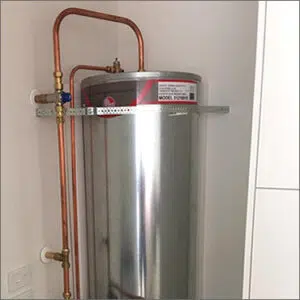Radiator
Radiator systems circulate hot water silently through the radiator and heat is emitted into the surrounding area using only the natural convection of warm air. Natural convection means the warm air heated by the radiator rises and cool air falls back to the heater to be heated. Traditionally radiators were made from cast iron, but more modern units are constructed from pressed steel. The pressed steel heats up and cools down a lot faster, making it the ideal component for New Zealand’s changing climate and busy lifestyles. Many of the later models have fins on the back or between panels, these fins increase the surface area available for heating the air.
How radiator works?
The radiators use a gas boiler to heat water and the hot water is pumped to the individual radiators throughout your home. The cooler water then returns to the boiler system to be reheated again and continues the cycle back to the radiators. Valves on each of the heating radiators control the temperature in individual rooms.
Fuel
The radiator boilers can use natural gas, LPG or diesel to run. In New Zealand, the most cost-effective option is natural gas
Advantages of Radiator
- It’s possible to have one or two radiators per room, this, of course, depends on the size of your room.
- It’s also possible to combine radiator heating and underfloor heating, which would suit a multilevel home or homes with timber and floor substrates.
- The system is controlled by a programmable remote which can be set to turn on and off at your convenience.
- You can add heated towel rails to the system, it keeps towels dry and prevents damp air.
- The system can be installed in a new home or added to an existing structure, but it is important to have enough space under the floor to lay pipework.
- Radiator systems are very economical as water carries more heat than air.
- Individual temperature control for each room.
- Safe to use around children.
- Particularly suited to older Villa-type homes.
Disadvantages of Radiator
- Central heating requires a significantly higher upfront cost when compared to room heaters.
- There is a time delay before heat output is changed to meet heating demand.
- There is limited control of each individual radiator unless a separate thermostat controls each individual unit.
- There is a need for space to house the central heating unit.
- You need suitable routes for pipes and ducts.
Aesthetics
Radiators come in a variety of styles and colours, this gives you plenty more options to choose a unit suitable for the colour scheme and decor of your home. The style of the radiators is particularly suited to Villa homes.
Price
The price is dependent on the number of radiators, type of fuel and amount of pipework. For an average home with 9 radiators and a natural gas boiler, systems cost upwards of $16,000
Gas fires
Gas fireplaces are the modern and stylish answer to traditional wood fireplaces. Built-in gas fires will heat your home cost-effectively and efficiently, no only saving you money on heating costs but also reducing environmental impacts. Gas fireplace design and technology has improved significantly over the last 20 years, meaning the latest models on the market offer the luxurious ambiance of fire while being surprisingly efficient.
How Gas Fire works?
The gas fireplaces contain incombustible “logs” that cover gas vents, while the fire itself burns behind a glass screen. It gives off both convicted and radiant heat.
Fuel
Gas fires can use either LPG or natural gas. Natural gas is a more cost-effective option.
Advantages of Gas Fire
- Modern fireplaces do not emit smoke and vents the combustion waste outside through the flue.
- Gas fireplaces push all the heat they create into the room, rather than losing it into the masonry.
- You don’t waste energy heating an entire home but only use energy to heat up the single room as required.
- Gas fires give you a lot more control, gas fires often have temperature control with a thermostat.
- They provide constant and reliable heat.
- The system does not need to be cleaned as no soot is made.
- Units are stylish and remote-controlled, these are very easy to operate.
- The gas fires are more environmentally friendly when compared to traditional wood-burning fireplaces.
Disadvantages of Gas Fire
- You will need to pay fixed charges for reticulated gas supply, it may be more expensive if you don’t have a reticulated gas supply in place already.
- If you do not have reticulated gas supply in your home, LPG is more expensive than natural gas.
- Compared with a central heating radiator system, a gas fireplace only heats up one room at a time. You’ll need several units in your home if you want each individual room heated.
- The gas fire will need electricity to run the internal fans and ignition source. The unit will not work during a power outage.
Aesthetics
You are spoiled by style choices when it comes to gas fireplaces, not only do these units provide ambiance they also come in a variety of designs to suit any home and decor. You have the option to have a Victorian-era elegance or chic modern chrome.
Price
The cost of installation varies a lot depending on the unit you’d like to install and the type of installation. In some cases, more work is required than in others and some units are more expensive than others.
If you’re looking to see which option is best suited to your home, its best to do your homework on all your options. The information out there is very overwhelming so if you’d like a consultation or a quote for your home, get in touch with us today. We can provide detailed advice and information on your options to help you make the best decision for your heating needs.

